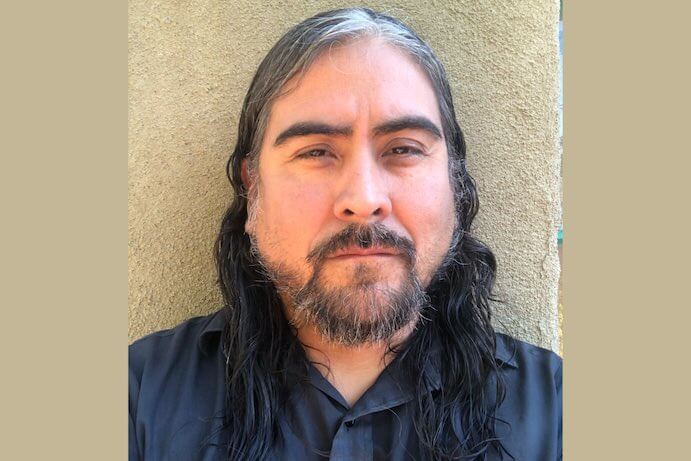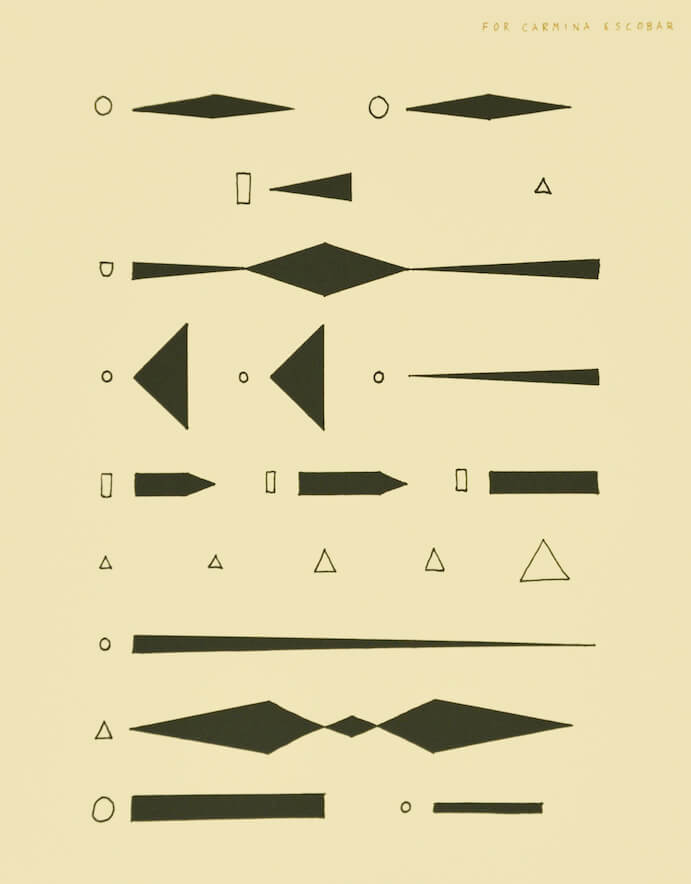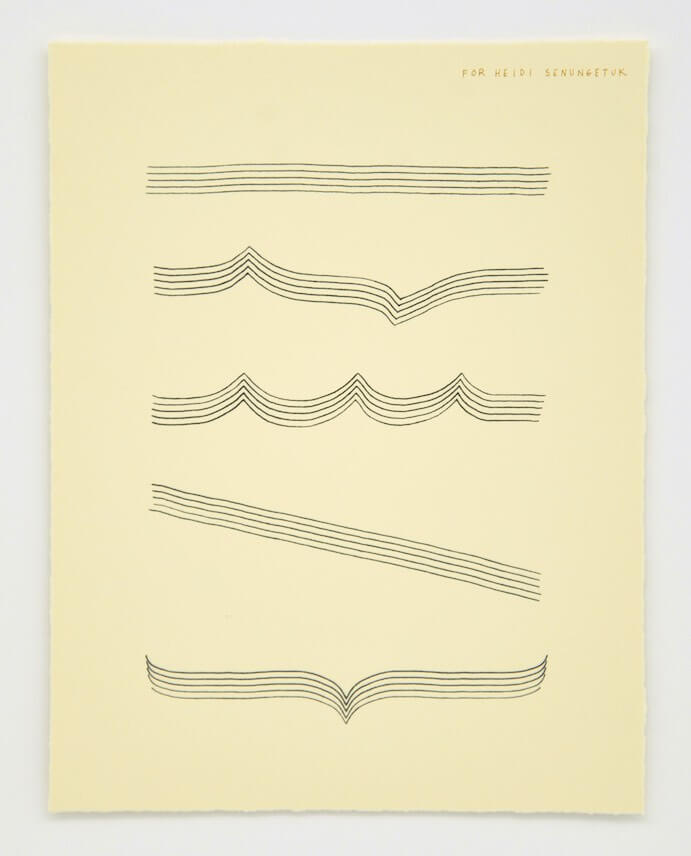There has been quite a buzz following Raven Chacon since he was awarded the 2022 Pulitzer Prize in Music this past May for his work Voiceless Mass (2021), a site-specific piece of chamber music composed for the Nichols & Simpson organ at The Cathedral of St. John the Evangelist in Milwaukee, Wisconsin.
Although the acclaim for this work is well-deserved, Chacon’s artistry extends far beyond the realm of chamber music — he also creates noise music, sound art, installation pieces, video works, visual art, and more. Working in different media offers Chacon the opportunity to keep exploring: “I think it’s [about] trying to find the best vehicle for relaying the concept or topic or narrative that I want to speak about, and the truth is, instrumental music isn’t always good at doing that.”
[Tweet “”I think it’s [about] trying to find the best vehicle for relaying the concept or topic or narrative that I want to speak about, and the truth is, instrumental music isn’t always good at doing that.””]
One recent project that highlights this careful consideration of medium and message is For Zitkála–Šá (2017–2020), a series of 13 scores that combine Chacon’s interests in graphic notation and experimental performance. The collection pays tribute to Zitkála–Šá (1876–1938), a Yankton Dakota woman who wrote the libretto and songs for The Sun Dance Opera (1910–1913), which is widely considered to be the first Native opera. However, her legacy goes beyond the concert hall — she was a writer, an educator, and an activist. She wrote allegorical fiction and essays that criticized the American Indian boarding school system (which she was subjected to as a child), spoke out about the inequality of women’s rights, and worked in the 1920s to unite American Indians to lobby for citizenship rights.
But in his research, Chacon discovered that Zitkála–Šá’s work was not without its contradictions and tensions. “Once I actually spoke to some Dakota people, I realized this woman’s life was a lot more complicated than that…When she was trying to get the right to vote for American Indian people, some people didn’t want that. Some people said, ‘Why should I align with you? I don’t even want to be part of this country.’”

Chacon initially considered writing a large-scale symphonic work to tell the story of Zitkála–Šá’s life and work outside of The Sun Dance Opera, but he ultimately felt the form was too big, too bombastic. Rather than settling on a biographical work, Chacon’s research led him somewhere else entirely. “It really got me thinking less about her and more about, well, who are we today? Who are the people that are talking about these same issues? Who are the artists and musicians that are thinking about these same issues?”
Each of the 13 graphic scores in For Zitkála–Šá is dedicated to a contemporary American Indian, First Nations, or Mestiza artist who works with sound in their practice: Laura Ortman, Cheryl L’Hirondelle, Suzanne Kite, Barbara Croall, Jacqueline Wilson, Autumn Chacon, Heidi Senungetuk, Ange Loft, Joy Harjo, Carmina Escobar, Olivia Shortt, Candice Hopkins, and Buffy Sainte-Marie. Chacon began by talking and listening to these artists about their interests, their philosophies on music, and how they saw themselves navigating the 21st century. The result is a dazzling array of single-page graphic scores, each accompanied by a brief set of instructions to aid interpretation.
“For Laura Ortman” from Raven Chacon’s For Zitkála–Šá
I first encountered For Zitkála–Šá at the 2022 Whitney Biennial’s Quiet as It’s Kept exhibition (which is on display through September 5, 2022). Amidst the sprawling presentation of works at the Biennial, Chacon’s scores stand out as unpretentious and candid in their use of simple geometric shapes, arrays of symbols, and playfully recontextualized Western notations. The set of works is visually cohesive and compelling, even though each piece draws upon a different lexicon of symbols. “They certainly function as portraitures of the people I wrote them for, and some of that might include information such as cultural aesthetics of their tribe…But at the same time, even though they can be very specific to the person’s biography, there’s room for their reinterpretation.”
The work dedicated to experimental vocalist Carmina Escobar invokes the horrors of erasure: “When you have no tongue to speak your original language, what is the sound of that scream?” Chacon uses symbols to mimic the shape of the mouth during performance, and following each of these symbols is a blackened shape that is meant to map the sound envelope — the volume and duration — of each quiet scream. Escobar’s quavering and gritty vocals convey an agonizing struggle – a powerful emotion belied by the score’s balanced geometric forms.

Chacon takes the blank five-line musical staff as the subject for the work dedicated to musical scholar Heidi Senungetuk. Below a single straight staff are four variations upon it where lines are bent into other forms: a wave pattern, a steady descent, the shape of a bird in flight. Chacon prompts the performer to compose a melody on tracing paper placed over the straight staff and to reinterpret it over each of the following bent staves in turn. To create this piece, Chacon used a five-line staff pen gifted to him from Segungetuk years prior. And embedded in it is a message about combating academia and its “relentless governing of the creative spirit” that scholars in creative fields often grapple with. “If the institution is going to change the rules, we must remind ourselves that we can also bend the system.”

In the piece dedicated to bassoonist Jacqueline Wilson, Chacon uses shaded and empty shapes (circles, triangles, squares, and diamonds) to indicate timbral changes. “It’s about finding yourself in different places, in different contexts as an Indigenous person, having to put on a set of clothes for a different meeting and going back home and having to readjust and realign yourself to the place that you are from…The best way for me to explain that situation was just through playing the same pitch. You’re just shapeshifting the tone.”

Works like For Zitkála–Šá fall somewhere at the intersection of score (to facilitate performance) and visual artwork (presented as the work itself). For a long time, Chacon considered the score to be an instruction manual, the purpose of which was to simply get sound out into the world. But over time, his thinking has changed: “Scores themselves can be the document to mediate every part of the work itself, to be a kind of feedback loop within itself, as supplemental information, as something that allows the music to continue to grow through its existence as being separate from the music, as well…Meaning that it’s not just the instruction manual anymore. It’s more information about the concept, the narrative, the biography, the concern, and it can have that other existence separate from the music.”
For Zitkála–Šá is available now in a 128-page softcover print edition via Art Metropole and New Documents. This edition collects all 13 graphic scores, their instructions, and a short essay by each of the artists. Chacon also includes an artist statement on each of the works. In flipping through this volume, I come back to the question of medium, specifically how For Zitkála–Šá could very well have been a fully notated orchestral work or even an opera. Would those media have been able to capture the intensely personal nature that Chacon’s graphic scores do? Would other media grant these formidable performers the same agency in telling their stories? Chacon’s dedication to finding the right medium for each project, or as he says, the “best vehicle” for relaying the message, is truly refreshing. And of his role in the process, Chacon says, “I wanted to be very careful that I’m not a man who’s instructing others what to do. I’m just a conduit for the story.”
I CARE IF YOU LISTEN is an editorially-independent program of the American Composers Forum, funded with generous donor and institutional support. Opinions expressed are solely those of the author and may not represent the views of ICIYL or ACF.
A gift to ACF helps support the work of ICIYL. For more on ACF, visit the “At ACF” section or composersforum.org.
























